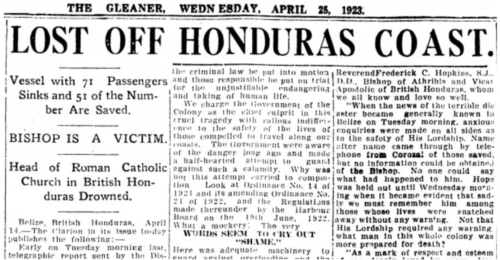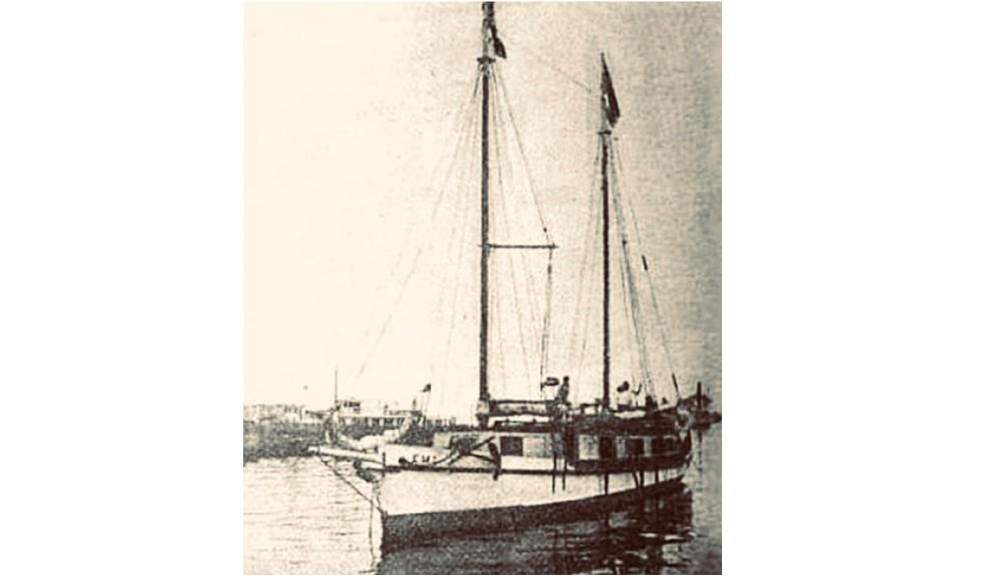by Donia Scott
Preface
In the dead of night exactly one hundred years ago, in April 1923, a mailboat named the E.M.L. sank off the coast of Sarteneja, British Honduras, taking with it the lives of 18 people. It is a story that has been lost to the passage of time. One might be tempted to think that it was not a noteworthy event. That would be wrong.
A few years ago, during a break while writing a scientific paper for a conference on Natural Language Processing (a field in Artificial Intelligence now making headlines about ChatGPT), I conducted a Google search of my much-loved maternal grandmother, Alice Marchand.
Born in British Honduras in 1888, she was a key figure in our Jamaican household. Like many middle-class women of her generation, her role was primarily that of housewife and mother. She was not associated with any of the public deeds or misdeeds that would normally warrant an internet presence. I had no expectation of finding anything.
Searches using several permutations of her name received no hits until I entered in the words “Mrs Lucio Marchand” – remembering that letters sent to her when I was a child were always addressed in this way. Success! Up popped the link to an article from the archives of a Jamaican newspaper, The Gleaner, dated the 25th of April 1923, apparently a reprint of a recent article from a British Honduran newspaper, The Clarion. This article reported a shipwreck that had occurred on the 10th of April in British Honduras. Yipes!

Granny would occasionally mention in passing, usually along with a story of Charles Lindbergh having landed his seaplane in front of her house, that she had been on a ship that sank off the Yucatan a long time ago, that one of her five children had drowned and that she had saved someone else’s little girl. But little otherwise. This article announced that very shipwreck. Not only was Granny mentioned by name, but she was referred to in glowing terms, recalling her bravery, especially compared to the male passengers and crew. It was also reported that a well-known Catholic bishop had drowned when the E.M.L. sank.
With more time on my hands during the COVID lockdown, I would occasionally run a Google search on the E.M.L., hoping that someone, somewhere would have uploaded some material on the event. I found a lot online about the Bishop, the Reverend Frederick Hopkins, S.J., on various sites belonging to the Catholic Church.
Then up popped my second big discovery, this time on the official Facebook site of the Belize Archives and Records Service. It was a detailed first-person testimony of the sinking of the ship, in the form of an extract from a Coroner’s Inquest into the event. The person providing the testimony was none other than Granny herself! Her story was heartbreaking. I emailed copies to several members of my family, with the subject title “Granny was a hero!”.
A distant cousin in Belize, Florencia Castillo, whom I had met briefly a few years earlier when my sisters and I took our mother to Belize as a birthday treat, very kindly directed me to a newly-formed Facebook group named “Belize National Historic Society”. Through this group, I learned a lot about the history and traditions of the country and members would answer my no-doubt naïve occasional questions (“What is a kraal?”, “A patakee?”). I soon realised that even amongst those with a deep interest in the history of that country, very little is known today about the shipwreck of the E.M.L. other than that it led to the drowning of a famous Bishop and three nuns. But among the many photographs of riverboats that were published on the site, were two of the E.M.L. Remarkably, I was also able to track down a daughter of the seven-year-old girl that Granny had saved, to whom she referred in her testimony as “a Sabido girl”. Eliza Jefferson and I had an emotional conversation over Facebook Messenger. Her mother, she said, was Sybil Sabido, and she was one of the survivors of the E.M.L.
I corresponded with Mary Alpuche, Archive Officer of the Belize Archives and Records Service, who generously devoted some of her time to finding copies of the weekly newspaper, The Clarion, for the period following the tragedy. She unearthed about 10 articles about the disaster. One contained extracts of a few other first-person testimonials given at the Coroner’s Inquest that followed.
Later, I was able to put many pieces of the puzzle together through visits to the National Archives at Kew in London, which houses in their staggeringly large collection of Colonial Records an almost complete set of the original correspondence and dispatches between the then Secretary of State for the Colonies, Lord Devonshire, and the Governor of British Honduras, Sir Eyre Hutson. It contained about 50 reports on the sinking of the E.M.L. and included the official report from the Coroner’s Inquest held in Corozal a few days after the sinking. Among the 27 depositions at the Inquest, there were 14 from surviving passengers and crew on board, each recounting their experience of the pandemonium that ensued during the 10 to 15 minutes that the ship went down. It was heart-racing stuff.
Armed with all this information, and supplemented with many forays with Google, I have been able to collect an almost complete account of the events surrounding the shipwreck, and of the lives of those who drowned. Missing, regrettably, is any verifiable information surrounding the two drowned children of Edwin Llewellyn Fuller of Orange Walk – Gladys (aged 10) and her unnamed sibling – other than that Gladys’s body was later identified by a relative on board, Henry Gustavus Longsworth, but the body of her sibling was never recovered.
This account is dedicated to those whose lives were tragically cut short off the coast near Sarteneja on the 10th of April 1923.
Lest we forget!
Donia Scott
8th April 2023.

